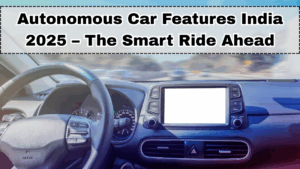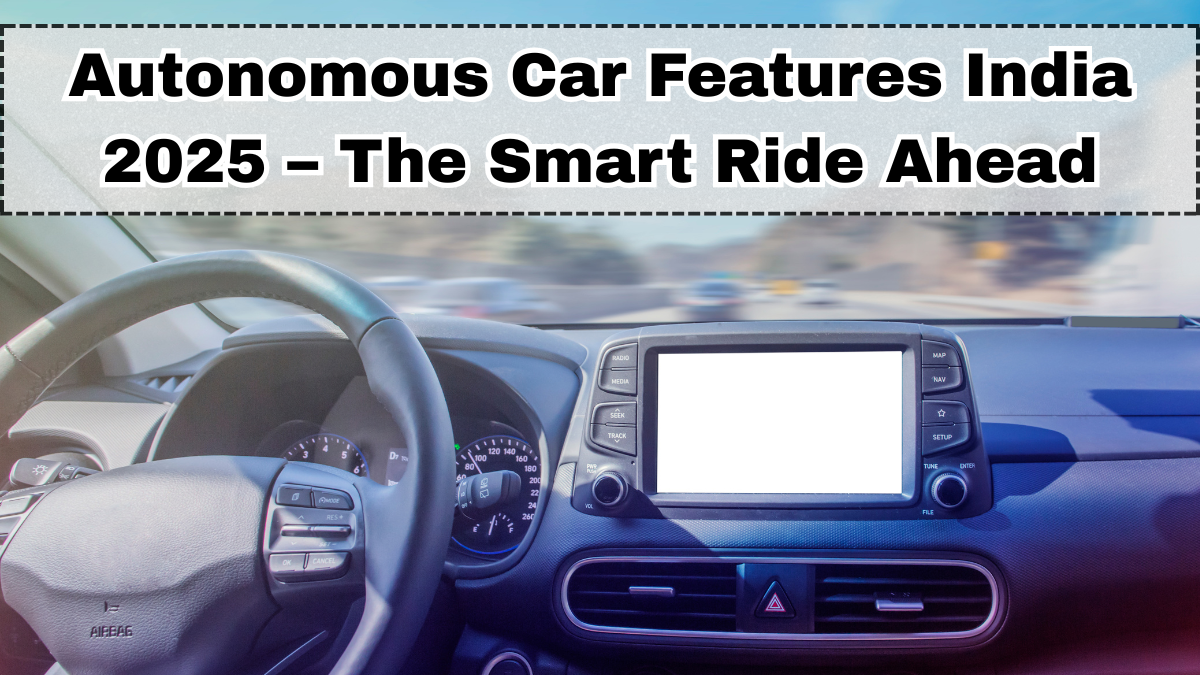The future of mobility is arriving faster than expected as Autonomous Car Features India 2025 make their way into mainstream and premium cars. Indian roads, long considered too unpredictable for automation, are now seeing rapid progress thanks to improved mapping, advanced sensors, AI integration, and smarter safety regulations. Automakers are equipping vehicles with more intelligent driver-assist systems, setting the foundation for semi-autonomous mobility across cities and highways. With upgraded connectivity, radar-based safety, and AI learning, 2025 is shaping up to be the breakthrough year for autonomous vehicles India 2025.
The new wave of automation is not just about self-driving; it’s about reducing human error, enhancing comfort, and improving road safety. Cars launching in 2025 will include smarter lane support, adaptive cruise control, predictive alerts, and highway assist systems. Global automotive giants and Indian manufacturers alike are investing heavily in radar, LiDAR, ultrasonic sensors, and camera-based systems to deliver safe, reliable automation under Indian conditions. As consumer demand for modern tech grows, these driver-assist features cars India are becoming a major selling point across segments.

What’s Powering India’s Autonomous Car Revolution?
The backbone of Autonomous Car Features India 2025 is a combination of hardware and software advancements. Carmakers are integrating high-resolution front cameras, 360° vision systems, and next-gen radar modules that can detect obstacles, lanes, and pedestrians with improved accuracy. Meanwhile, AI-powered software processes real-time data to predict braking distances, road patterns, and potential collision scenarios. Enhanced GPS accuracy, supported by India’s NavIC satellite system, further helps in route precision and automated highway manoeuvres.
Automakers like Tata, Mahindra, Hyundai, Kia, MG, and BMW are pushing Level 1 and Level 2 autonomous features across sedans, SUVs, and EVs. These technologies not only make driving easier but also significantly reduce fatigue, especially on long trips. With India’s new safety standards encouraging ADAS adoption, features once available only in luxury cars will now reach mid-range models too.
Top Autonomous Driving Features Coming to Indian Cars in 2025
1. Adaptive Cruise Control with Stop & Go
Cars launching in 2025 will include adaptive cruise control that automatically adjusts speed based on the vehicle ahead. In heavy traffic, the Stop & Go function lets the car brake completely and resume movement without driver input, easing bumper-to-bumper driving.
2. Lane Keep Assist & Lane Departure Warning
These systems monitor lane markings and gently correct the steering if the vehicle drifts. With India upgrading road markings on key highways, lane assist will work more consistently across premium and mid-segment vehicles.
3. Autonomous Emergency Braking (AEB)
AEB automatically applies brakes when the system detects sudden obstacles, pedestrians, or potential collisions. As part of driver-assist features cars India, this tech is becoming mandatory for several upcoming models.
4. Traffic Jam Assist
Traffic Jam Assist combines adaptive cruise control and lane assistance to semi-automate crawling traffic. This is especially useful in cities like Delhi, Mumbai, and Bengaluru.
5. Highway Assist & Hands-Free Modes
Highway Assist allows semi-autonomous driving on controlled roads. With the expansion of expressways, these features will become more reliable and practical in 2025.
6. AI-Powered Driver Monitoring
Using cameras and sensors, this system detects driver fatigue, distraction, and drowsiness. If required, it issues alerts or even slows the vehicle automatically.
How Carmakers Are Adapting These Features for Indian Roads
India’s traffic ecosystem is unique — unpredictable turns, animals on roads, non-standard lane discipline, and mixed-speed traffic. To address this, automakers have tuned Autonomous Car Features India 2025 with localized algorithms. Vehicles learn from real-world conditions, improving recognition of two-wheelers, buses, pedestrians, and even roadside vendors. AI adaptiveness is now a core element of automation, allowing cars to differentiate between safe gaps and risky manoeuvres.
New mapping upgrades are also accelerating progress. HD maps, real-time traffic feeds, and geo-fenced autonomous zones on expressways are helping brands deliver more reliable automation. The government’s focus on improving road quality and uniform signboards ensures that camera-based systems work more efficiently.
Why 2025 Is the Turning Point for Autonomous Cars in India
Several trends are converging to make autonomous vehicles India 2025 the next big mobility shift:
• Rapid electrification is encouraging carmakers to integrate advanced software platforms
• EVs are launching with centralized computers ideal for ADAS functions
• Better 5G coverage supports real-time data sharing
• Safer car structures allow better integration of sensors
• Consumers now prioritise tech-equipped cars over pure performance
As a result, autonomous features are no longer reserved for luxury cars. Models from Tata, Mahindra, MG, and Hyundai are set to bring ADAS Level 2 to the ₹10–₹25 lakh range — a major milestone for Indian customers.
Buyer Benefits: Why Autonomous Features Matter
The biggest advantage of automation is safety. Over 70% of road accidents in India occur due to human error, and ADAS can dramatically reduce risks. Features like AEB, blind-spot detection, and forward collision warning help avoid crashes before they occur. Automation also enhances comfort by reducing driver fatigue during long highway journeys and city congestion. Cars with these features also hold higher resale value, making them long-term investments.
From a technology perspective, cars are becoming smarter, more connected, and more intuitive. Drivers can expect smoother acceleration, smarter braking, and predictive decision-making — all contributing to a more enjoyable drive.
FAQs
What autonomous level will Indian cars reach in 2025?
Most cars will offer Level 1 and Level 2 autonomous features, including lane assist, adaptive cruise control, and emergency braking.
Are autonomous features safe for Indian roads?
Yes, automakers are tuning systems specifically for Indian traffic behaviour and improving AI learning for local conditions.
Will autonomous cars be more expensive?
Prices may increase slightly due to additional sensors, but growing demand and local manufacturing are reducing costs.
Which cars will have the most advanced autonomous features in 2025?
Upcoming models from Tesla (expected), MG, Hyundai, Tata, Mahindra, and Kia are expected to offer some of the most advanced systems.
Do autonomous features work in traffic?
Yes, Traffic Jam Assist and Stop & Go systems automate crawling speeds, making commuting less tiring.
Click here to know more.
